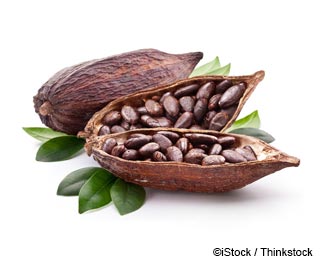Crazy About Cacao
Botanical name: Theobroma cacao

One of the most popular trees on the planet is cacao, the plant species from which cocoa is derived. While some might think cacao and cocoa are one and the same, they're not. Cacao is the tree, while cocoa is the dry, powdered product made from it. Cocoa is best known as the main ingredient for an all-time favorite confection worldwide — chocolate.1
A cacao pod is a dark brown ovoid fruit containing about 60 seeds, better known as cacao beans.2 The flavor is dependent on the fermentation of the cacao beans. During this process, compounds found in the beans react with each other, producing the well-loved flavor of chocolate.3
Aside from their flavor, cacao beans were prized for their medicinal and aphrodisiacal properties, and they were traded like currency by South American civilizations. For the Aztecs and Mayans, cacao beans were so important in feasts and celebrations that they were usually put at the center.4
Today, in the dawn of superfoods, cacao has earned its title as a "superfruit" due to the surplus of flavonoids and polyphenols it contains.
Health Benefits of Cacao
There's been plenty of discussion about free radicals and antioxidants, but some are unsure of what these terms mean regarding our health. Exposure to radiation, cigarette smoke, pollution and certain medications may all release free radical activity in the body; however, they also can be produced by factors like mental stress, infections, cancer and aging.5
Antioxidants in the foods you eat may help reverse this process by zapping harmful free radicals, helping fight off disease.6 This is where cacao comes in. Compared to other foods, it is well-equipped with phenolic antioxidants, be it catechins, epicatechins or procyanidins.7 Its beans are also rich in magnesium, copper, potassium and calcium, which are known to help lower the risk of hypertension and heart disease.8
Aside from these benefits, cocoa may help alleviate the symptoms of depression, attention deficit hyperactivity disorder (ADHD) and schizophrenia through its beta-phenylethylamine (PEA) content. PEA works as a neurotransmitter and may improve serotonin concentrations in the brain by interacting with trace amine-associated receptor (TAAR).9
For those who think chocolate must be bad for you (it has to be if it tastes so good, right?), rest assured that there's roughly 1 gram of sugar in a half-cup serving of raw cacao. However, this doesn't apply to some store-bought chocolate because of all the flavor additives that mask the powder's bitterness.10
Cacao Nutrition Facts
Serving Size: 3.5 ounces (100 grams), dry powder, unsweetened
| Calories |
228 |
|
| Total Fat |
13.7 g |
|
| Saturated Fat |
8.07 g |
|
| Trans Fat |
|
|
| Cholesterol |
0 mg |
|
| Sodium |
21 mg |
|
| Total Carbohydrates |
57.9 g |
|
| Dietary Fiber |
37 g |
|
| Sugar |
1.75 g |
|
| Protein |
19.6 g |
|
| Calcium 128 mg |
Iron |
13.86 mg |
Studies on Cacao
According to a 2003 study from the Journal of Agriculture and Food Chemistry, black tea, green tea, red wine and cocoa contain high levels of phenolic phytochemicals, such as theaflavin, epigallocatechin gallate, resveratrol and procyanidin, which have been studied due to their possible chemopreventive properties. Of the four food products investigated, cocoa contained the highest levels of phenolic and flavonoid content, which gives it its strong antioxidant abilities.11
A 2012 study from Current Hypertension Reports showed that while eating lots of fruits and vegetables lowered the risk of coronary heart disease and stroke, a similar effect was found in cocoa due to its high phenolic content. The researchers noted that cocoa may help lower blood pressure and improve vascular function by activating nitric oxide synthase or increasing the bioavailability of nitric oxide.12
Cacao Healthy Recipes:
Keto Coconut Cacao Nests Recipe

Procedure:
- Melt the coconut oil in a double boiler. Stir in the raw cacao powder and monk fruit (or stevia); mix until smooth.
- Remove the boiler from heat, and then stir in the shredded coconut. Spoon the mixture into six muffin tins with paper liners. Create a divot in the center of each "nest" with a spoon, then freeze for 10 minutes.
- Once hardened, place two macadamia nuts in the center of each nest and serve.
(Recipe from PaleoHacks)
Cacao Fun Facts
In ancient times, cacao was so revered by Mesoamerican people that its consumption was reserved for priests, high-ranking officials, military officers and great warriors only. Women and children were not allowed to taste cacao as they were deemed unsuitable.13
Summary
I say cocoa, you say cacao, but there is a slight difference: Cacao is the tree that cocoa is derived from. This substance contains amazingly powerful nutrients. Raw cacao powder contains a surplus of phytochemicals and minerals, including protein, calcium, carotene, thiamin, riboflavin, magnesium and sulfur. These properties can be destroyed by high heat, so it's important to know what type of processes your cocoa powder and baking chocolate have undergone.
Cacao may help improve heart health, cholesterol, stress levels and inflammation, to list just a few physical advantages. It may also help alleviate the symptoms of depression, ADHD and schizophrenia. All this satisfying goodness comes from a frothy mug of hot cocoa or a creamy bar of unadulterated chocolate. It's no wonder that it's historically called "black gold."14